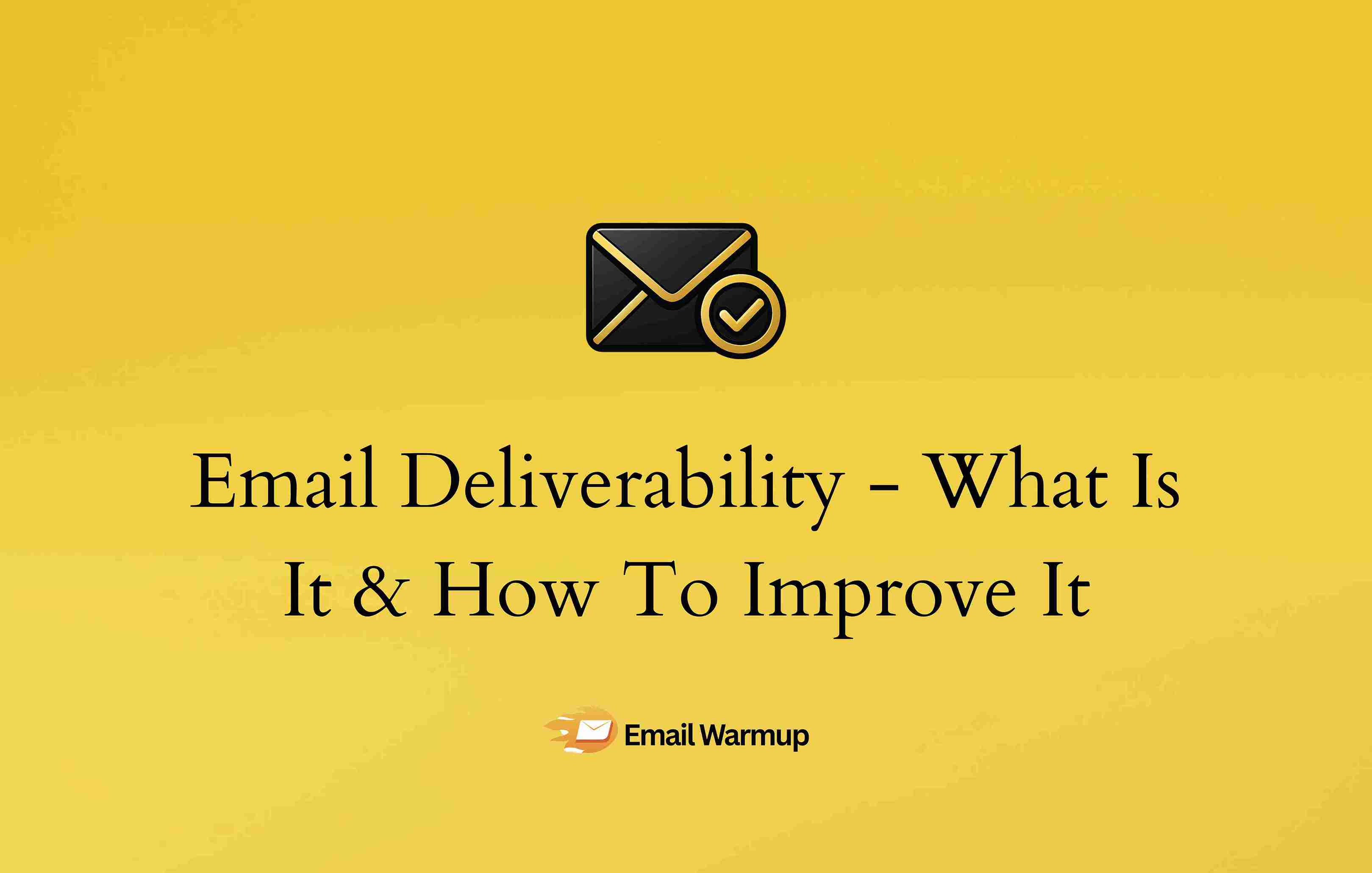
A “delivered” status means nothing if your email ended up in the spam folder, because what good is a message if it’s not read?
Several email marketing campaigns are often crushed due to poor email deliverability, and it’s a fundamental concept to understand. Most people confuse deliverability with delivery, but they are two different things.
Email deliverability refers to the success rate of emails reaching recipients’ inboxes, specifically the primary inbox, rather than spam or other folders.
So that means your emails might have been delivered, but the question is, where?
As an email deliverability consultant who has helped hundreds of businesses execute successful campaigns, I’ve prepped this guide to answer:
- What is email deliverability?
- What sender reputation is (and how to fix it)
- How to avoid common spam triggers and blocklists
- Tools and tactics to boost inbox placement instantly
- The 6 key metrics inbox providers actually care about
Let’s ensure your emails are seen, opened, and acted upon, rather than being ignored, bounced, or blacklisted.
A word of advice
Getting your emails into the inbox is just the first step. The real challenge is ensuring that the emails delivered actually drive the business results you need.

Try EmailWarmup.com and get:
- Better delivery rates with constant monitoring
- Clean email lists with validation and replacement
- An email warmup that adjusts to how much you send
- Your own IP addresses to protect your sender’s reputation
- Expert help whenever you need it, with unlimited support calls
Want us to show you how it works?
Schedule your consultation call
What is email deliverability, and why does it matter?
Email deliverability refers to the ability of your emails to reach your recipient’s primary inbox, not just the promotions tab, and certainly not the spam folder.
It’s often confused with email delivery, which simply means a server accepted the email, but that doesn’t guarantee visibility or action.
Spending thousands on email campaigns, only to have your messages flagged by spam filters or blocked by mailbox providers like Gmail or Outlook, is a recipe for disaster.
Poor deliverability means your recipients don’t see your offer, brand, or call to action because the messages end up as emails going to spam.
So, what influences email deliverability?
- Your sender reputation
- Your authentication setup
- The quality of your email list
- How your audience interacts with your emails.
We’ll look into each of these issues in the piece.
What are the key metrics that reveal your deliverability health?
Understanding email deliverability starts with measuring it, as you can’t improve what you can’t track. These are the core metrics that mailbox providers use to determine where your emails are directed (inbox, promotions, or spam).
Inbox placement rate (IPR)
Email deliverability refers to the percentage of emails that reach the primary inbox, not just the server.
If you send 100 emails and 95 land in the primary inbox while 5 end up in spam, your IPR is 95%.
However, if those same 100 emails are delivered to the server (showing 100% delivery), but only 40 land in spam, your IPR drops to 60%.

- Anything below 85% signals trouble
- 95%+ is excellent and indicates a strong sender reputation
- You can use an email deliverability test to simulate inbox placement testing
Bounce rate (hard vs. soft)
Bounce rate refers to the percentage of emails that fail to reach their intended recipients.
It is a crucial metric in email marketing that helps assess the quality of an email list and the effectiveness of a campaign.
Bounces are typically categorized into hard and soft bounces, each with different causes and impacts on deliverability.
| Bounce Type | Description | Cause | Impact | Resolution |
| Hard Bounce | Permanent delivery failure due to invalid or non-existent email addresses. | Non-existent or misspelled email addresses | Indicates poor email list hygiene, leading to a lower sender reputation and a higher chance of emails being flagged as spam. | Remove invalid email addresses from your list. |
| Soft Bounce | Temporary delivery failure, often due to issues like a full inbox, server errors, or email size limits. | Full inbox, server errors, or email size limits | Doesn’t significantly harm the sender reputation, but repeated soft bounces can escalate into hard bounces, harming deliverability. | Wait and retry sending the email later. Resolve issues like large attachments. |
The ideal rate is less than 2% total across both types.
Now, both are different, but if soft bounces persist and continue without resolution, they can eventually turn into hard bounces, further damaging your sender reputation.
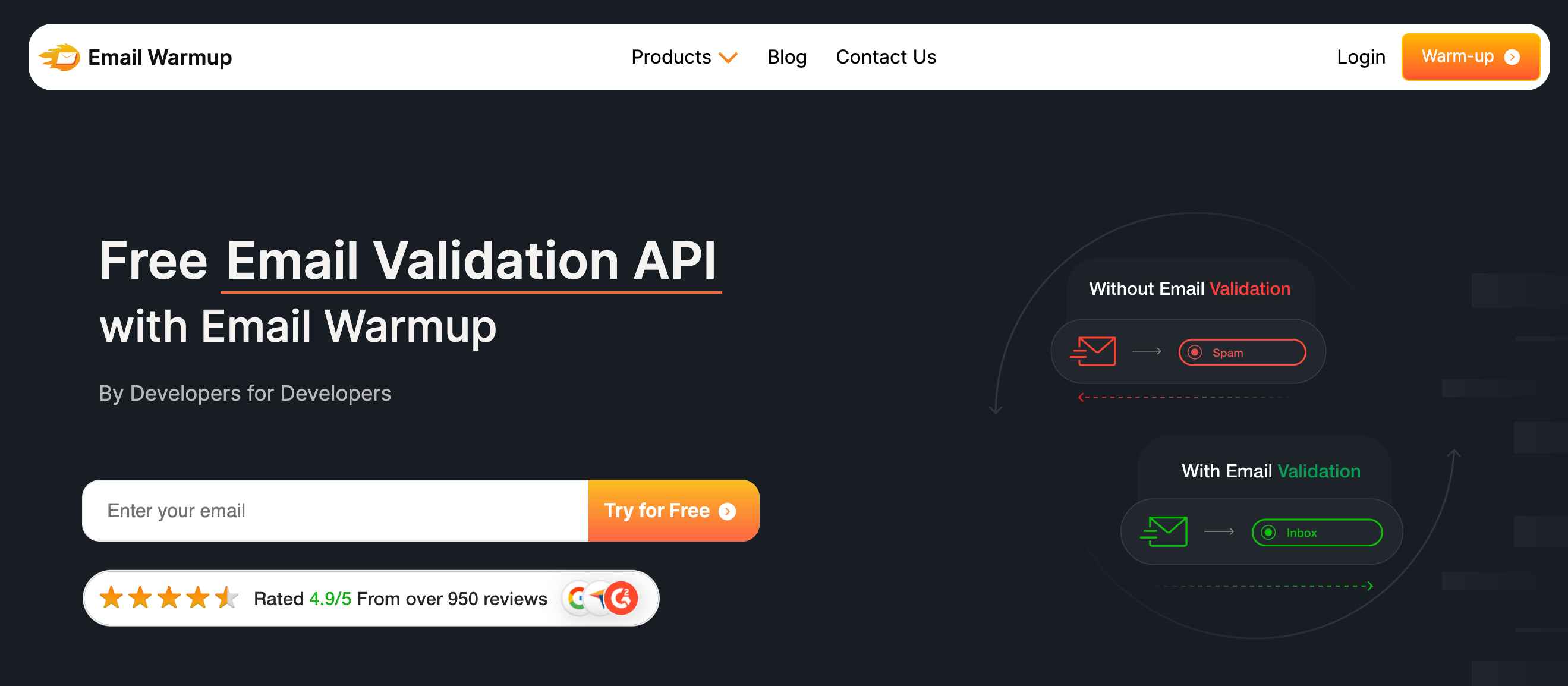
To prevent that from happening, you can use EmailWarmup.com’s email validation API to keep your list clean.
Open rate, CTR, and spam complaints
When someone opens your email, clicks a link, or replies, they’re sending positive signals to mailbox providers.
Conversely, when recipients consistently ignore your emails, delete them unread, or mark them as spam, you’re training the filters to treat your domain as unwanted.
Here are some recommended ranges for these metrics and their impact:
| Metric | Description | Recommended range | Impact |
| CTR (Click-Through Rate) | Measures the percentage of recipients who clicked on a link within the email. | 2–5% of total emails sent | A low CTR suggests poor engagement, which may negatively affect sender reputation and deliverability. |
| Spam Complaint Rate | Represents the percentage of recipients who mark your email as spam. | Must stay below 0.1% (0.3% can trigger filters) | Higher spam complaints can result in emails being flagged as spam, reducing deliverability. |
| Open Rate | Indicates the percentage of recipients who opened the email. | 20–30% minimum | A low open rate may indicate poor subject lines or irrelevant content, which could harm sender reputation. Apple’s Mail Privacy Protection may impact this metric. |
Alongside CTR, monitor your click to open rate to understand how engaging your content is once the email is opened.
How do mailbox providers decide your inbox fate?
Getting into the inbox goes beyond what you write, it’s about the invisible technical decisions that email mailbox providers use to judge your legitimacy.
SPF, DKIM, and DMARC
If you’re not authenticating your emails, you’re inviting spam into your inbox.
Together, these protocols prove your identity to ISPs, and without them, you’re flagged as suspicious or worse, spoofable. Here are more details on each protocol:
- DKIM (DomainKeys Identified Mail)
Ensures the content wasn’t altered during transmission. Learn how to setup DKIM so recipients can verify you signed the message. - SPF (Sender Policy Framework)
Confirms which IP addresses are allowed to send email for your domain - DMARC (Domain-based Message Authentication Reporting & Conformance)
Tells inbox providers how to handle failed messages. Learn how to set up DMARC correctly.
IP address reputation (shared vs. dedicated)
Your email sends come from an IP address, and that address has a reputation.
- With a dedicated IP, you control the outcome, but only if you manage it correctly.
- With shared IP, your sender reputation is affected by others using the same IP.
Now, a shared IP is cheaper, but if you’re sending at scale, a dedicated IP gives you a clean slate, assuming you warm it up and follow proper protocols.
Modern spam filters
Modern spam filters don’t just look for trigger words. They run AI-powered checks across:
- Authentication setup
- Sending volume changes
- Link behavior and content formatting
- Past user engagement with your domain
Even one bad signal can trip the algorithm. The safest strategy is to maintain consistency, have a clean technical setup, and build your reputation over time.
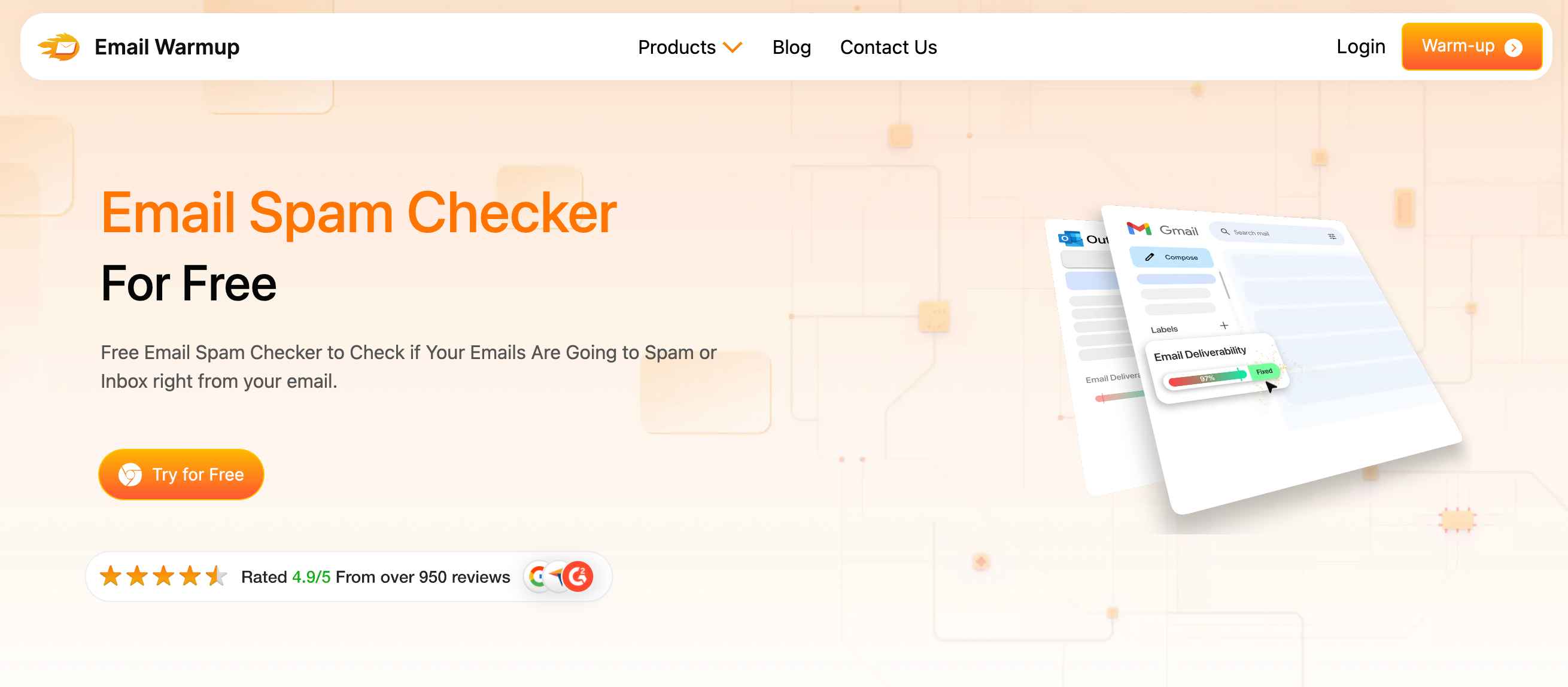
You can use a free Chrome extension, Email Spam Checker, that tells you what percentage of your emails are landing in the inbox.
What is sender reputation, and how does it work?
Your sender reputation is like a credit score, but for email. It’s how mailbox providers decide if they can trust you.
Domain vs. IP reputation
- IP Reputation
Tied to the IP address you send from. Bad neighbors can sink your inbox placement if you’re on a shared IP. - Domain Reputation
Linked to your actual domain. It follows you across platforms and tools, so switching ESPs won’t fix a damaged domain.
Both matter, but in the long term, your domain reputation is what mailbox providers track and remember.
Subscriber behavior equals trust score
How recipients interact with your emails feeds directly into your score.
| Positive signals | Negative signals |
| Opening, clicking, replying | Marking as spam |
| Adding your email to contacts | Ignoring for weeks |
| Moving your email from spam to the inbox | Deleting without reading |
List hygiene and spam trap avoidance
Bad lists destroy good reputations. If you’re sending to expired addresses, email spam traps, or unengaged users, you’re training mailbox providers to distrust your domain.
Clean lists, regular engagement, and smart segmentation are key to building and maintaining a reputation that inboxes welcome.
Why is email list hygiene so important?
List hygiene forms the foundation of high deliverability. You can have the perfect content and warmest domain, but if your email list is full of dead ends and disengaged users, your sender reputation will plummet.
Why double sign-in protects your deliverability
Double sign-in requires a user to confirm their subscription before being added to your list, and it:
- Filters out fake or mistyped emails
- Helps protect against spam traps and bots
- Confirms they actually want to hear from you
- Sets the tone for consent and builds brand trust
Regular cleaning and bounce removal
Even valid addresses go stale over time. People change jobs, abandon inboxes, or stop caring. The key tactics include:
- Remove hard bounces immediately
- Clear out inactive subscribers after 6–12 months
- Watch soft bounces over time (repeated issues mean removal)
You can run re-engagement campaigns first, but don’t be afraid to suppress non-responders. It’s better to send to 1,000 engaged users than 10,000 ghosts.
Segment based on engagement
Instead of sending the same message to everyone:
- Send targeted reactivation sequences
- Create segments based on open/click activity
- Adjust frequency or content type for inactive users
Segmentation enhances inbox placement and boosts CTR while safeguarding your deliverability score.
What content factors affect deliverability?
You could be doing everything else right, and still land in spam, if your content sends the wrong signals to inbox providers.
Subject lines and preview text
Your subject line is the first trigger that mailbox providers and users see.
| Avoid | Do |
| ALL CAPS | Keep it under 50 characters |
| Overuse of punctuation (!!!) | Use personalization when possible |
| Spammy phrases like “Buy now” or “Risk-free offer” | Align the subject with the body copy |
Text-image balance and formatting
Sending image-only emails can be a bad idea as spam filters treat these as suspicious. So make sure you:
- Include ALT text for all images
- Use clean, mobile-responsive HTML
- Avoid embedding links inside images
- Aim for a 60:40 ratio of text to images
CTAs, kinks, and unsubscribe clarity
Too many CTAs or links scream spam, so always make sure that you:
- Use HTTPS links
- Use 1 clear call to action
- Always include a clear, one-click unsubscribe link
- Avoid shortened URLs or mismatched anchor text
Mailbox providers look at how easy it is for users to unsubscribe. If you make it hard, they’ll mark your domain as untrustworthy.
How do you warm up new domains and IPs?
Launching a cold domain or IP address without a warmup triggers spam filters and destroys your sender reputation from day one.
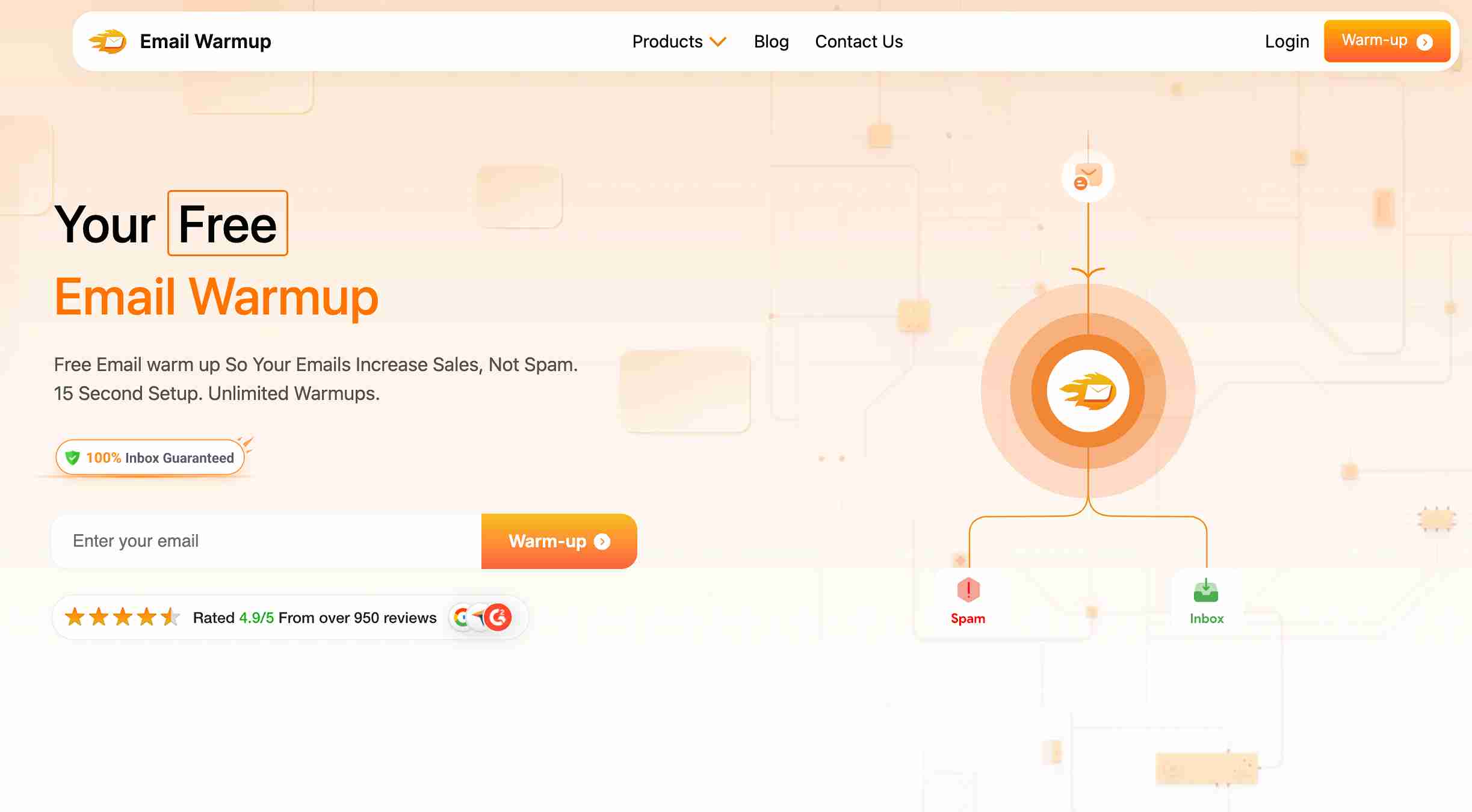
Email warmup is the gradual process of sending emails in controlled volumes, starting with your most engaged recipients.
The process includes:
- Monitor bounce rates, opens, and complaints
- Slowly increase daily volume over 2–4 weeks
- Don’t rush (a single spike can ruin your sender reputation)
- Start by sending small batches (50–100 emails/day) to active, previously engaged contacts
For high-volume senders, a dedicated IP is essential. You control the reputation, but you must manage it properly.
Now you don’t have to go for a DIY.
With EmailWarmup.com, you can automate the entire process seamlessly and also obtain a dedicated IP address to work with.
What do successful deliverability fixes look like?
Businesses have transformed their email performance by addressing core deliverability issues, and the results speak for themselves. Here are some real-life examples:
Canva (fixing onboarding dropoff with warmup)
Canva’s beautifully designed onboarding emails were landing in spam folders, causing users to abandon the signup process. The problem was sending high volumes from a cold IP address without proper warm-up.
The solution was to systematically warm up their email IP by starting with small batches sent to engaged existing users, then slowly increasing volume.
They also redesigned their onboarding flow to focus on engagement rather than just information delivery.
As a result, they achieved 95% inbox placement, along with a 38% drop in onboarding abandonment.
UNICEF (re-engaging donors through list hygiene)
UNICEF’s donor email list had grown organically, but engagement was declining and bounce rates were climbing.
Their list contained thousands of outdated addresses, creating hard bounces that damaged their sender reputation.
The solution was to go for a comprehensive list cleaning, removing invalid addresses, and creating targeted re-engagement campaigns. They removed nearly 30% of their original list size.
As a result, they saw a 72% reduction in bounce rates and 25% increase in engagement from remaining subscribers.
Zalora (personalization plus deliverability for abandoned carts)
Zalora discovered their abandoned cart recovery emails weren’t reaching customers due to poor IP reputation and authentication issues.
They migrated to a better email infrastructure, implemented proper authentication, and created dynamic emails with personalized recommendations based on shopping patterns.
As a result, they saw a measurable lift in cart recovery performance contributing to overall revenue growth.
American Lung Association (donor campaign improvement)
The association’s advocacy emails were getting buried in spam folders during critical legislative periods.
They implemented double sign-in, simplified unsubscribe process, and segmented lists based on engagement levels.
Also, they removed subscribers who hadn’t engaged in over a year.
As a result, they saw a 10% improvement in inbox placement led to increased donations and advocacy actions.
What trends are shaping email deliverability in 2025?
Email providers are changing the rules faster than most businesses can adapt. The following trends will determine whether your messages reach inboxes or get lost in spam folders.
DMARC enforcement is now mandatory
Google, Yahoo, and Microsoft now require SPF, DKIM, and DMARC for anyone sending over 5,000 emails/day.
Even if you don’t hit that threshold, having proper authentication proves domain legitimacy and improves inbox placement.
AI spam filters are getting smarter
Modern spam filters analyze behavior, history, and engagement patterns using AI.
This means sending irrelevant content hurts over time, engagement rates are weighted more heavily, and poor signals can quickly blacklist your domain.
Apple’s mail privacy protection (MPP) is killing open rate reliability
Apple now preloads all email content, artificially inflating open rates.
Inbox providers are shifting their focus to clicks, replies, and spam complaints, rather than opens.
Post-cookie retargeting shifts
With Chrome phasing out third-party cookies, businesses are increasingly turning to first-party data, such as email lists.
Your email list has become your most valuable targeting asset.
The crux of the matter is…
If you’re constantly asking why are my emails going to spam, focus on fixing the deliverability fundamentals first, as discussed in the blog.
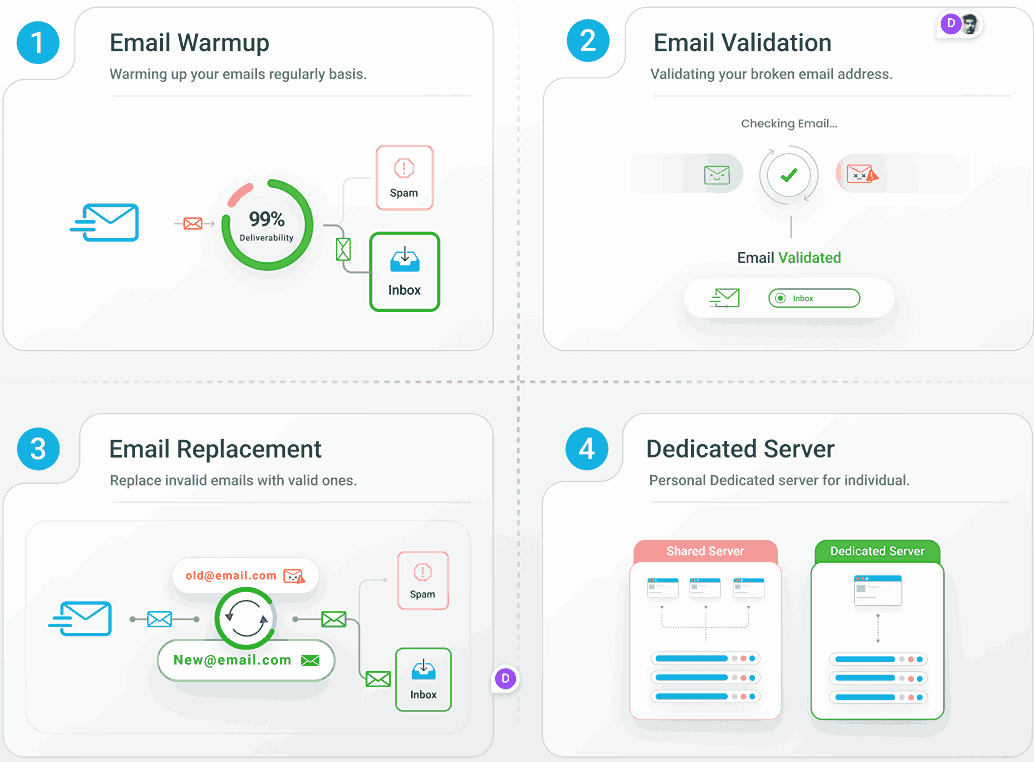
But eventually, you need a system that works, and EmailWarmup.com offers:
- Better delivery rates with constant monitoring
- Clean email lists with validation and replacement
- An email warmup that adjusts to how much you send
- Your own IP addresses to protect your sender’s reputation
- Expert help whenever you need it, with unlimited support calls
Stop watching your best emails disappear into spam folders.
Get started with a free 30-day (no-strings-attached) trial?
Frequently asked questions about email deliverability
Here are some frequently asked questions on this topic:
Mailbox providers now expect every sender to publish all three authentication records (SPF, DKIM, and DMARC), use TLS encryption, and keep spam complaint rates below 0.30%. You need to actively monitor these records, consistently warm up sending IP addresses, remove inactive users every 60–90 days, and test campaigns before launching.
Start by verifying the alignment of SPF, DKIM, and DMARC. Make sure the “From” domain matches your storefront domain. Check content for spam triggers and avoid promotional language in transactional emails to ensure a seamless user experience. If authentication and content are fine, consider switching to a provider that specializes in transactional sending.
SPF lists authorized IP addresses for your domain. DKIM cryptographically signs messages to prove they haven’t been altered. DMARC ties them together and sets policy for authentication failures. Deploy with “p=none” first to monitor, then gradually shift to “p=quarantine” or “p=reject.”
Modern filters analyze the entire email structure, not just keywords. Red flags include misleading subject lines, repetitive links, and image-heavy layouts. Maintain 60:40 text-to-image ratios, avoid link shorteners, and always include working unsubscribe links. Use spam preview tools before launching campaigns.
Use double sign-in, remove inactive users quarterly, and throttle volume for new lists. Monitor reputation; if blacklisted, pause sending, identify the root cause, and then request removal through official channels. Slowly warm up reputation after delisting.


